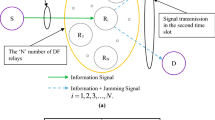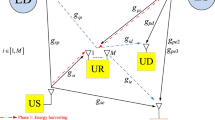Abstract
The security rate optimization problem of a multi-antenna decode-and-forward full-duplex relay system powered by simultaneous wireless information and power transfer is studied. A system model and secure transmission scheme based on energy cooperation and cooperative jamming are presented. The full-duplex relay node works in a power splitting mode for energy collection and information decoding. Artificial noise is injected when the relay forwards the information signals for cooperative jamming. As the relay is equipped with multi-antenna, beamforming technology is used to improve the signal-to-noise ratio of the destination node by adjusting the antenna array matrix. To maximize the security rate, and with consideration to energy cooperation and cooperative jamming performance, the optimal values of the energy collection factor and the cooperative jamming power allocation factor are obtained and the calculation process is also given. The simulation results show that the proposed secure transmission scheme can effectively improve the security rate of the system.











Similar content being viewed by others
References
Krikidis, I., Timotheou, S., & Nikolaou, S. G. (2014). Simultaneous wireless information and power transfer in modern communication systems. IEEE Communications Magazine,52(11), 104–110.
Del-Valle-Soto, C., Mex-Perera, C., Monroy, R., & Nolazco-Flores, J. A. (2017). MPH-M, AODV-M and DSR-M performance evaluation under jamming attacks. Sensors,17(7), 1573.
Zhang, R., & Ho, C. K. (2013). MIMO broadcasting for simultaneous wireless information and power transfer. IEEE Transactions on Wireless Communications,12(5), 1989–2001.
Chen, X. M., Ng, D. W. K., Gerstacker, W. H., & Chen, H. H. (2017). A survey on multiple-antenna techniques for physical layer security. IEEE Communications Surveys & Tutorials.,19(2), 1027–1053.
Wu, Y. P., Khisti, A., Xiao, C. S., & Caire, G. (2018). A survey of physical layer security techniques for 5G wireless networks and challenges ahead. IEEE Journal on Selected Areas in Communications,36(4), 679–695.
Wang, D., Bai, B., Zhao, W. B., & Han, H. (2019). A survey of optimization approaches for wireless physical layer security. IEEE Communications Surveys & Tutorials,21(2), 1878–1911.
Kumar, S., Kaur, M., Singh, N. K., Singh, K., & Chauhan, P. S. (2018). Energy detection based spectrum sensing for gamma shadowed α − η − μ and fading channels. AEU-International Journal of Electronics and Communications,93(2018), 26–31.
Kumar, S., Chauhan, P. S., Raghuwanshi, P., & Kaur, M. (2018). ED performance over α − η − μ/IG and α − κ− μ/IG generalized fading channels with diversity reception and cooperative sensing: A unified approach. AEU-International Journal of Electronics and Communications,97(2018), 273–279.
Rasethuntsa, T. R., & Kumar, S. (2019). An integrated performance evaluation of ED-based spectrum sensing over α −κ − μ and α − κ − μ-extreme fading channels. Transactions on Emerging Telecommunications Technologies. https://doi.org/10.1002/ett.3569.
Nguyen, H. S., Do, D. T., & Nguyen, T. S. (2017). Exploiting hybrid time switching-based and power splitting-based relaying protocol in wireless powered communication networks with outdated channel state information. Automatika,58(1), 111–118.
Do, D. T. (2016). Energy-aware two-way relaying networks under imperfect hardware: optimal throughput design and analysis. Telecommunication Systems,62(2), 449–459.
Liu, X. L., Li, Z., & Wang, C. (2018). Secure decode-and-forward relay SWIPT systems with power splitting schemes. IEEE Transactions on Vehicular Technology,67(8), 7341–7354.
Li, Q. Z., & Qin, J. Y. (2017). Joint source and relay secure beamforming for nonregenerative MIMO relay systems with wireless information and power transfer. IEEE Transactions on Vehicular Technology,66(7), 5853–5865.
Feng, Y. H., Yang, Z., & Zhu, W. P. (2017). Robust cooperative secure beamforming for simultaneous wireless information and power transfer in amplify-and-forward relay networks. IEEE Transactions on Vehicular Technology,66(3), 2354–2366.
Zhang, G. C., Li, X. Y., Cui, M., Li, G. P., & Yang, L. (2016). Signal and artificial noise beamforming for secure simultaneous wireless information and power transfer multiple-input multiple-output relaying systems. IET Communications,10(7), 796–804.
Ghosh, S., Acharya, T., & Maity, P. S. (2019). On outage minimization in RF energy harvesting relay assisted bidirectional communication. Wireless Networks. https://doi.org/10.1007/s11276-018-01924-1.
Salem, A., Hamdi, K. A., & Rabie, K. M. (2016). Physical layer security with RF energy harvesting in AF multi-antenna relaying networks. IEEE Transactions on Communications,64(7), 3025–3038.
Gu, Y., & Aissa, S. (2015). RF-based energy harvesting in decode-and-forward relaying systems: Ergodic and outage capacities. IEEE Transactions on Wireless Communications,4(11), 6425–6434.
Ghosh, S., Acharya, T., & Maity, S. P. (2017). Outage analysis in two-way communication with RF energy harvesting relay and co-channel interference. Transactions on Emerging Telecommunications Technologies. https://doi.org/10.1002/ett.3233.
Lv, L., Chen, J., & Yang, L. (2017). Improving physical layer security in untrusted relay networks: cooperative jamming and power allocation. IET Communications,11(3), 393–399.
Li, Q., Yang, Y., & Ma, W. K. (2015). Robust cooperative beamforming and artificial noise design for physical-layer security in AF multi-antenna multi-relay networks. IEEE Transactions on Signal Processing,63(1), 206–220.
Nguyen, X. X., & Do, D. T. (2017). Optimal power allocation and throughput performance of full-duplex DF relaying networks with wireless power transfer-aware channel. EURASIP Journal on Wireless Communications and Networking,2017, 152. https://doi.org/10.1186/s13638-017-0936-x.
Chen, G., Gong, Y., & Xiao, P. (2015). Physical layer network security in the full-duplex relay system. IEEE Transaction on Information Forensics and Security,10(3), 574–583.
Zhu, F. C., Gao, F. F., & Zhang, T. (2016). Physical-layer security for full-duplex communications with self-interference mitigation. IEEE Transactions on Wireless Communications,15(1), 329–340.
Tang, X. X., Yang, W. D., & Cai, Y. M. (2017). Security of full-duplex jamming SWIPT system with multiple non-colluding eavesdroppers. In 2017 7th IEEE international conference on electronics information and emergency communication (ICEIEC), pp. 66–69.
Noschese, S., Pasquini, L., & Reichel, L. (2013). Tridiagonal toeplitz matrices: Properties and novel applications. Numerical Linear Algebra with Applications,20(2), 302–326.
Mobini, Z., & Mohammadi, M. (2019). Wireless-powered full-duplex relay and friendly jamming for secure cooperative communications. IEEE Transactions on Information Forensics and Security,14(3), 621–634.
Acknowledgements
This work is supported by the National Science and Technology Major Project of China under Grants No. 2018ZX03001026-002 and the Doctoral Candidate Innovative Talent Project of Chongqing University of Posts and Telecommunications under Grant BYJS201807.
Author information
Authors and Affiliations
Corresponding author
Additional information
Publisher's Note
Springer Nature remains neutral with regard to jurisdictional claims in published maps and institutional affiliations.
Rights and permissions
About this article
Cite this article
Zhang, M., Zheng, J. & He, Y. Secure transmission scheme for SWIPT-powered full-duplex relay system with multi-antenna based on energy cooperation and cooperative jamming. Telecommun Syst 74, 55–66 (2020). https://doi.org/10.1007/s11235-019-00642-z
Published:
Issue Date:
DOI: https://doi.org/10.1007/s11235-019-00642-z




